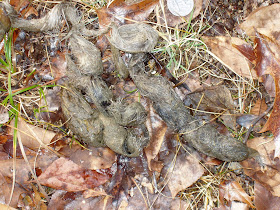Ben Caruthers sent me this picture with a note, "Do we have a scatologist in the group?" Blowing it up (the photo, that is) I could see what appeared to be pieces of the shiny black elytras of a beetle. On further questioning he said it was an inch long, had insect parts and there were three on his back patio. I suggested that they might be raccoon poop although theirs are usually neatly piled together and the site reused in what is called a latrine.
Ben emailed me back and identified it correctly as toad scat. He frequently sees toads and insects on his patio. Of course, unless you saw the amphibian in action you can't be toadly certain. This was embarrassing to me as a retired gastroenterologist, being beaten to a diagnosis by a birder. I found a good resource on scat identification which described toad droppings.
"Droppings can be found in the same area morning after morning, often near flood lights as toads are drawn to insects attracted to the night lights. You may see exoskeletons of insects in the scat."
I started sniffing out internet resources. The OCTrackers Litter Box has a lot of detailed poop on poop. Toad scat tends to be small and sausage shaped and breaking it apart you would expect to find undigested insect remnants. Another thought I had was good old INaturalist. I sent in this picture of coyote scat with its usual heavy load of hair and Bingo! the top choice was coyote. They even have an INaturalist Scatology page.
The term "scatology" has two definitions, the first being "interest in or treatment of obscene matters especially in literature." Our definition as naturalists is "the biologically oriented study of excrement." There is now an official proposed term for the scientific study of poop, In Fimo, described in my old standby professional journal, Gastroenterology.

